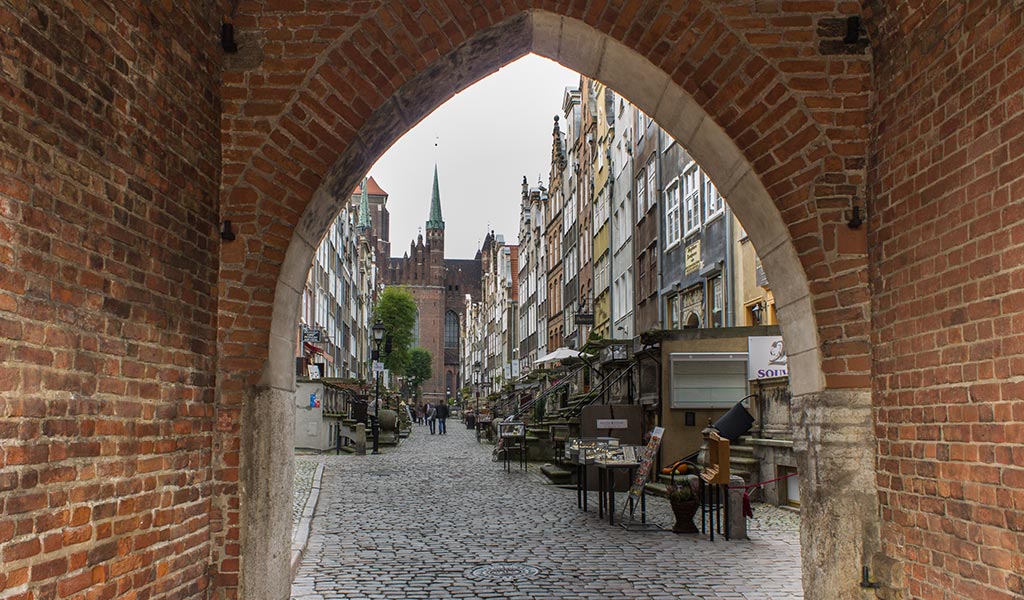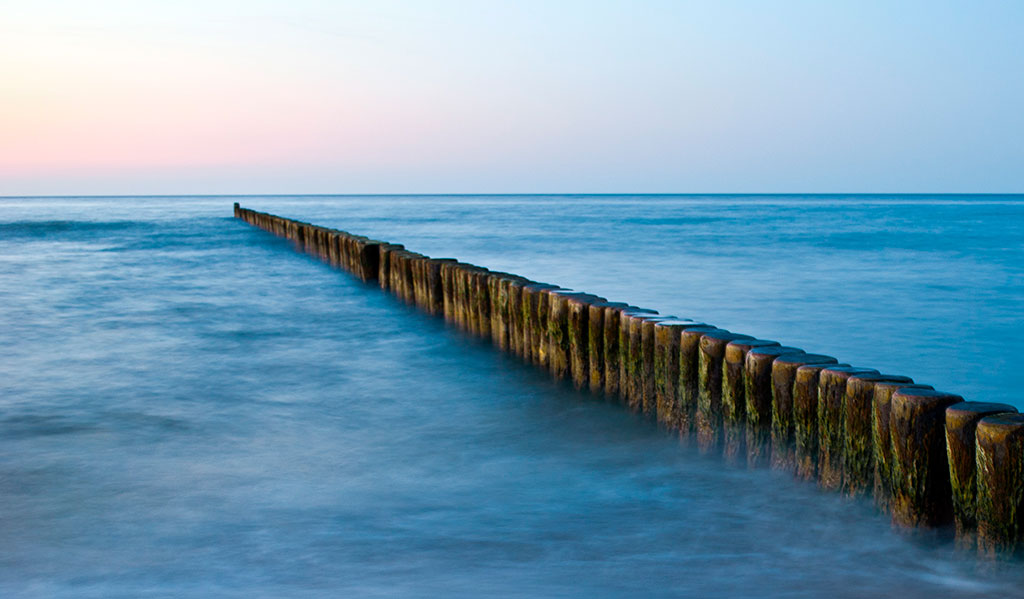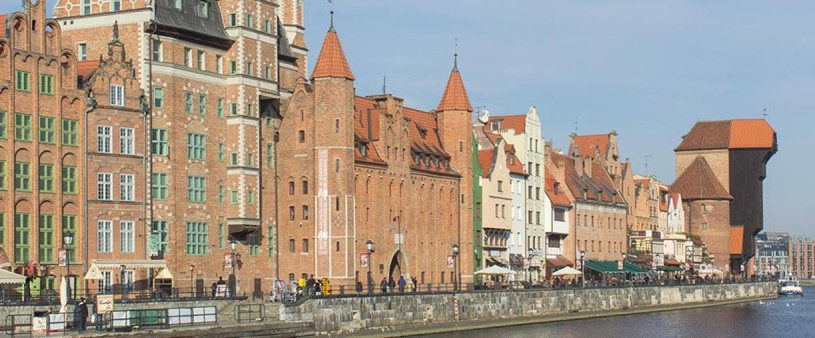The exciting history of Gdansk, an idyllic town at the Motlawa, goes back about 1000 years. Today Gdansk offers a lot of places of interest.
In World War II Gdansk was destroyed almost completely by Soviet forces, but nearly all buildings were reconstructed from historic models.
Almost all places of interest are located in the historic old town (Glowne Miasto) within a few 100 metres, so the walks are very diverting. The main streets, the Long Street, as well as Long Market, accommodate the most of the interesting buildings.
Furthermore, excursions to the surrounding area of Gdansk are worth it. Along the coast, as well as on Hel Peninsula, you find wonderful beaches. The Pomeranian Lakeland with its forests and fields is unique and fantastic, and the Castle in Malbork you shouldn’t miss at all — majestic, rough and beautiful at once.
1. St. Mary’s Church (Bazylika Mariacka)
Behind the town hall St. Mary’s rises like built for eternity.
With 105 metres length and 66 metres width, it is one of world’s biggest brick churches. Inside the three-naved hall church, with its filigree net and stellar vaults and its 37 huge windows, there is room for about 25.000 people.
Big parts of the precious interior decorations were lost in World War II. 500 tomb slabs, the three-bladed high altar and the copy of the world-famous drawing: „The Last Judgement“ of Hans Memling (the original is in the National Museum) were preserved.
One of the church’s biggest attractions is the 12 metres high astronomic clock from 1470, which sets in motions its figures play daily at 12 o’clock.
In no case you should miss a visit of the tower, which is 80 metres high, and the view is fantastic. However, you need endurance and you should be free from giddiness to climb up the 400 steps to the top.
2. Mariacka Street (ul. Mariacka)

Mariacka Street
Mariacka Street is situated between St. Mary’s and the promenade, perhaps one of the most beautiful streets of Gdansk.
In the small, richly decorated private town-houses, with its famous elevated terraces, you find a lot of bars and cafés, which invite to stay.
In the cellars of the houses a lot of small galleries, craft shops and amber shops are located. If you want to take home a souvenir made of amber, you are absolutely right in this street.
3. Artus Court
Already in 1342 the court was first mentioned.
At first, it served as meeting point for rich aristocrats and merchants. Until today a beer counter reminds to this gatherings.
The building burnt down in 1476 and the court was rebuilt in late gothic style. Rebuilding actions in renaissance style followed and later an attic, as well as the sculptures next to the windows, which symbolise the virtues of the citizenry.
The pompous interior of the court is worth seeing. Next to some renaissance paintings and late gothic sculptures, the 12 metres high renaissance tiled stove, with its 268 coloured tiles, from 1546 is awesome and you shouldn’t miss Anton Möller’s „Last Judgement“.
4. Amber Museum
The resin from the Baltic Sea is closely connected to the „golden“ city, so this museum is an absolute must-see.
Once, the torture chamber, the pillory and the city jail were located in the historic complex of buildings. Today you can discover the evolutionary history, the collection, the trade routes and the artful manufacture of amber on 5 floors.
Modern architecture, multimedia elements and modern installations make this exhibition absolutely well worth seeing.
Furthermore, the exhibition is dedicated to the history of the building. In the brick red gothic tower, which is connected with the torment chamber, you can still see leg and neck irons, handcuffs, as well as instruments of torture in the cells.
5. The Westerplatte
On the Westerplatte history was made.
On September 1, 1939, the Polish ammunition dump, which was built on the Peninsula in the Vistula entry, was pounded by the German Ship „Schleswig-Holstein“ — this was the beginning of World War II.
1.500 German soldiers attacked the 182 Polish soldiers, positioned on the Westerplatte, with heavy ordnance and airplanes. This was not an easy task, as they thought it would be. The Polish defenders offered grim resistance for 7 days, until they surrendered.
Today the destroyed barracks, the bunker and a small exhibition in an old guard house are evidence for the combats. Since 1966 the Westerplatte Monument commemorates the battle of 1939. For the Pole Westerplatte still is the symbol of resistance against Nazi Germany.
6. Hel Peninsula

Hel Peninsula
Between dunes and pine forests — Hel is worth a day trip.
3 times a day the ferries of the White Fleet go to Hel from Gdansk and Sopot (Here you find the timetable and more information). Alternatively you go by car, driving time is about 1 hour to Władysławowo.
The South side of Hel, the so-called Puck Bay, is ideal for fans of water sports. While the North side offers wonderful beaches, which are suitable for long walks.
In the small fishing village Hel, at the Southern tip of the peninsula, the visit of the seal colony is worth a visit. Furthermore, the village woos with wide beaches, picturesque dunes and scores of small pubs, which offer simple but tasty fish dishes.
More information about Hel you find on the website of the village.
7. Malbork

Malbork
Malbork is the old capital of the Crusaders and the biggest European gothic fortification. You easily reach the city from Gdansk by car, by train it also takes just 45 minutes.
Malbork Castle, majestic, rough and at the same time beautiful, is a UNESCO World Heritage and World Natural Heritage Site, and can be visited on different guided tours. Amongst others, a nocturnal tour is possible. Here you find more informationabout the Castle Museum and the guided tours and you can also by you entry tickets online.
But Malbork is not only the castle. The area is famous for the so-called Zulawy-landscape. Once Dutch Protestants settled here, who left the unique houses and the canal system to the city.
So don’t miss to explore the city — it’s worth it.
Have fun in Gdansk!
Please leave a short comment, if you liked the article and tell me about your experiences in Gdansk.
P.S. In case you want to finish the day in a relaxed atmosphere, after the exploration of the city and its surroundings, here you find 5 bars and cafes in Gdansk, which are worth a visit.
 English
English
 English
English  Deutsch
Deutsch  Polski
Polski 


Leave a Reply